stool test(粪便检查 英文)
- 格式:ppt
- 大小:1.15 MB
- 文档页数:30
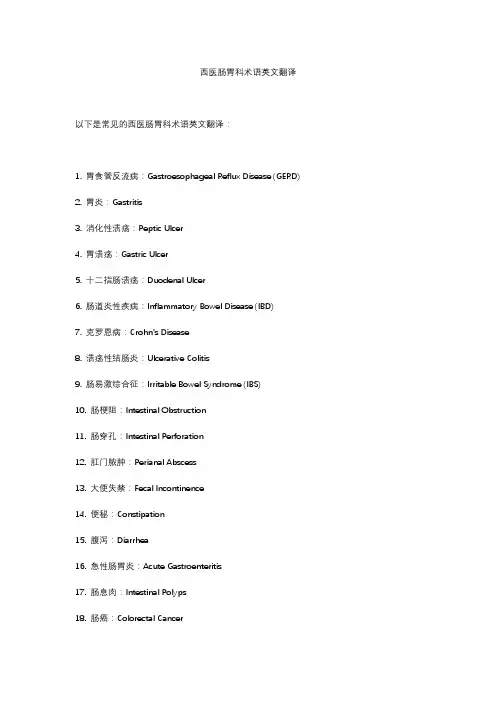
西医肠胃科术语英文翻译以下是常见的西医肠胃科术语英文翻译:1. 胃食管反流病:Gastroesophageal Reflux Disease (GERD)2. 胃炎:Gastritis3. 消化性溃疡:Peptic Ulcer4. 胃溃疡:Gastric Ulcer5. 十二指肠溃疡:Duodenal Ulcer6. 肠道炎性疾病:Inflammatory Bowel Disease (IBD)7. 克罗恩病:Crohn's Disease8. 溃疡性结肠炎:Ulcerative Colitis9. 肠易激综合征:Irritable Bowel Syndrome (IBS)10. 肠梗阻:Intestinal Obstruction11. 肠穿孔:Intestinal Perforation12. 肛门脓肿:Perianal Abscess13. 大便失禁:Fecal Incontinence14. 便秘:Constipation15. 腹泻:Diarrhea16. 急性肠胃炎:Acute Gastroenteritis17. 肠息肉:Intestinal Polyps18. 肠癌:Colorectal Cancer19. 胃镜检查:Esophagogastroduodenoscopy (EGD)20. 肠镜检查:Colonoscopy21. X线钡剂灌肠检查:Barium Enema X-ray Examination22. 大便潜血试验:Fecal Occult Blood Test (FOBT)23. 腹部平片检查:Abdominal Plain Film Examination24. 腹部CT检查:Abdominal CT Scan25. 直肠指诊:Digital Rectal Examination (DRE)26. 内窥镜超声检查:Endoscopic Ultrasonography (EUS)27. 上消化道出血:Upper Gastrointestinal Bleeding28. 下消化道出血:Lower Gastrointestinal Bleeding29. 幽门螺杆菌检测:Helicobacter Pylori Detection30. 肝功能检查:Liver Function Tests (LFTs)31. 胃肠道营养支持:Gastrointestinal Nutrition Support32. 全肠外营养支持:Total Parenteral Nutrition (TPN)33. 内镜下息肉摘除术:Endoscopic Polypectomy34. 肛周脓肿切开引流术:Perianal Abscess Incision and Drainage35. 大肠癌根治术:Radical Resection of Colorectal Cancer36. 胃肠道转流手术:Gastrointestinal Bypass Surgery37. 人工肛门括约肌成形术:Artificial Sphincter Placement Surgery38. 肠道微生物移植:Fecal Microbiota Transplantation (FMT)39. 小肠移植:Small Bowel Transplantation40. 造口术及造口护理:Stoma Surgery and Stoma Care41. 胃癌根治术:Radical Resection of Gastric Cancer42. 胰腺炎治疗:Pancreatitis Management43. 胆道疾病治疗:Biliary Tract Disease Management44. 功能性胃肠疾病的心理治疗:Psychological Therapies for Functional Gastrointestinal Disorders (FGIDs)45. 小肠镜检与治疗:Capsule Endoscopy and Therapy for Small Bowel Conditions。
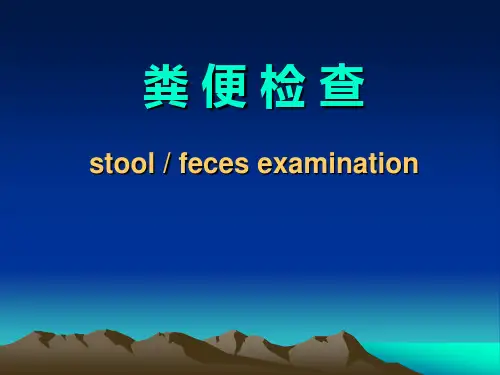
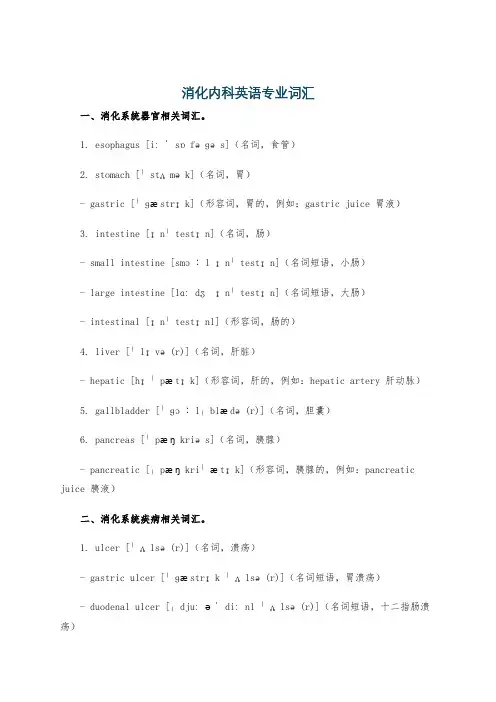
消化内科英语专业词汇一、消化系统器官相关词汇。
1. esophagus [iːˈsɒfəɡəs](名词,食管)2. stomach [ˈstʌmək](名词,胃)- gastric [ˈɡæstrɪk](形容词,胃的,例如:gastric juice 胃液)3. intestine [ɪnˈtestɪn](名词,肠)- small intestine [smɔːl ɪnˈtestɪn](名词短语,小肠)- large intestine [lɑːdʒɪnˈtestɪn](名词短语,大肠)- intestinal [ɪnˈtestɪnl](形容词,肠的)4. liver [ˈlɪvə(r)](名词,肝脏)- hepatic [hɪˈpætɪk](形容词,肝的,例如:hepatic artery 肝动脉)5. gallbladder [ˈɡɔːlˌblædə(r)](名词,胆囊)6. pancreas [ˈpæŋkriəs](名词,胰腺)- pancreatic [ˌpæŋkriˈætɪk](形容词,胰腺的,例如:pancreatic juice 胰液)二、消化系统疾病相关词汇。
1. ulcer [ˈʌlsə(r)](名词,溃疡)- gastric ulcer [ˈɡæstrɪk ˈʌlsə(r)](名词短语,胃溃疡)- duodenal ulcer [ˌdjuːəˈdiːnl ˈʌlsə(r)](名词短语,十二指肠溃疡)2. gastritis [ɡæˈstraɪtɪs](名词,胃炎)3. enteritis [ˌentəˈraɪtɪs](名词,肠炎)4. hepatitis [ˌhepəˈtaɪtɪs](名词,肝炎)- hepatitis A [ˌhepəˈtaɪtɪs eɪ](名词短语,甲型肝炎)- hepatitis B [ˌhepəˈtaɪtɪs biː](名词短语,乙型肝炎)5. cirrhosis [sɪˈrəʊsɪs](名词,肝硬化)6. pancreatitis [ˌpæŋkriəˈtaɪtɪs](名词,胰腺炎)7. cholecystitis [ˌkɒlɪsɪˈstaɪtɪs](名词,胆囊炎)三、消化内科检查相关词汇。


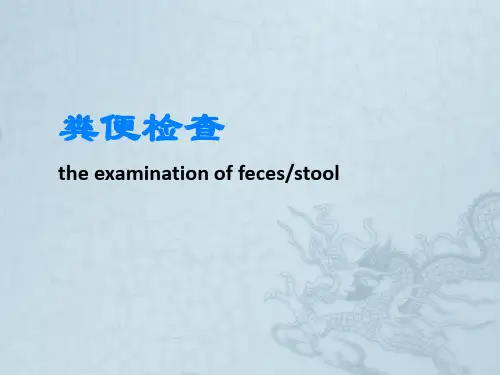

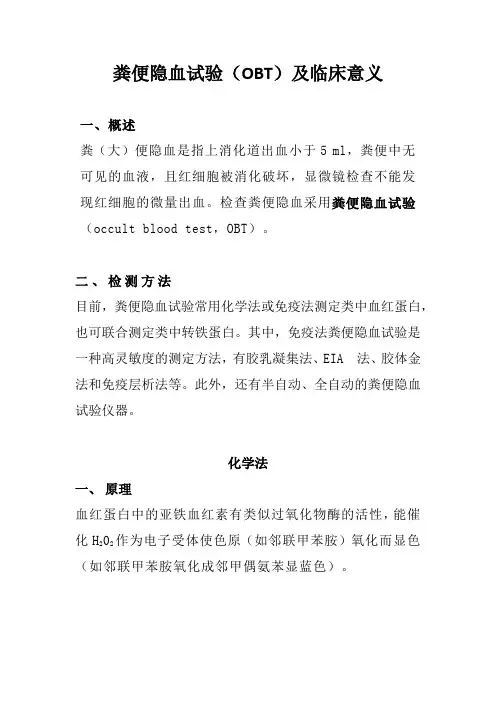
粪便隐血试验(OBT)及临床意义一、概述粪(大)便隐血是指上消化道出血小于5 ml,粪便中无可见的血液,且红细胞被消化破坏,显微镜检查不能发现红细胞的微量出血。
检查粪便隐血采用粪便隐血试验(occult blood test,OBT)。
二、检测方法目前,粪便隐血试验常用化学法或免疫法测定类中血红蛋白,也可联合测定类中转铁蛋白。
其中,免疫法粪便隐血试验是一种高灵敏度的测定方法,有胶乳凝集法、EIA 法、胶体金法和免疫层析法等。
此外,还有半自动、全自动的粪便隐血试验仪器。
化学法一、原理血红蛋白中的亚铁血红素有类似过氧化物酶的活性,能催化H202作为电子受体使色原(如邻联甲苯胺)氧化而显色(如邻联甲苯胺氧化成邻甲偶氨苯显蓝色)。
二、试剂1、10g/L邻联甲苯胺冰醋酸溶液2、3%过氧化氢液。
三、操作1、用小木棍挑取少量粪便,涂在消毒棉签或白瓷板上。
2、滴加10g/L邻联甲苯胺冰醋酸溶液2~3滴于粪便上。
3、滴加3%过氧化氢液2~3滴。
4、立即观察结果,在2分钟内显蓝色为阳性。
四、结果判定1、阴性:加人试剂2分钟后仍不显色。
2、阳性+:加人试剂10秒后,由浅蓝色渐变蓝色。
3、阳性2+:加人试剂后初显浅蓝褐色,逐渐呈明显蓝褐色。
4、阳性3+:加人试剂后立即呈现蓝褐色。
5、阳性4+:加入试剂后立即呈现蓝黑褐色。
五、注意事项1、3%过氧化氢液易变质失效,须进行阳性对照试验,将过氧化氢滴在血片上,应产生大量泡沫。
2、齿龈出血、鼻出血、月经血等可导致阳性反应。
3、用具应加热处理(如试管、玻片、滴管等)以破坏污染的过氧化物酶。
4、也可选用中等敏感(0.3~1mg Hb/g粪便)的愈创木酯法,但必须选购质量优良的愈创木酯,配制成20g/L愈创木酯乙醇溶液,代替10g/L邻联甲苯胺冰醋酸溶液,操作同上。
免疫法一、原理采用抗人血红蛋白的单克隆抗体或多克隆抗体,与粪便样品中的人血红蛋白特异性结合以检测类便中有无血液。
本试验不受动物血红蛋白的干扰,试验前不须禁食肉类。
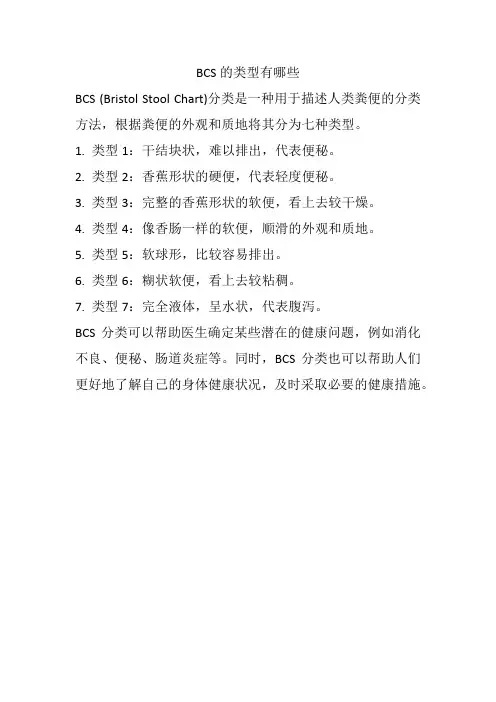
BCS的类型有哪些
BCS (Bristol Stool Chart)分类是一种用于描述人类粪便的分类方法,根据粪便的外观和质地将其分为七种类型。
1. 类型1:干结块状,难以排出,代表便秘。
2. 类型2:香蕉形状的硬便,代表轻度便秘。
3. 类型3:完整的香蕉形状的软便,看上去较干燥。
4. 类型4:像香肠一样的软便,顺滑的外观和质地。
5. 类型5:软球形,比较容易排出。
6. 类型6:糊状软便,看上去较粘稠。
7. 类型7:完全液体,呈水状,代表腹泻。
BCS分类可以帮助医生确定某些潜在的健康问题,例如消化不良、便秘、肠道炎症等。
同时,BCS分类也可以帮助人们更好地了解自己的身体健康状况,及时采取必要的健康措施。

医学常用医学检查中英文翻译Medical Translation of Common Medical Examinations between Chinese and EnglishIntroduction:In the field of medicine, accurate and effective communication is crucial, especially when it comes to medical examinations. With the increasing globalization of healthcare, there is a growing demand for accurate translation of medical examination terms between Chinese and English. This article aims to provide a comprehensive translation guide for common medical examinations used in clinical practice.1. Blood Tests1.1 Complete Blood Count (CBC)- 中文翻译:全血细胞计数(CBC)- 血球计数包括:红细胞计数、血红蛋白浓度、红细胞压积、白细胞计数及不同类型的白细胞计数- 英文翻译:Red Blood Cell Count, Hemoglobin Concentration, Hematocrit, White Blood Cell Count, and Differential White Blood Cell Count1.2 Blood Sugar Test- 中文翻译:血糖测定- 用于检测血液中的葡萄糖水平- 英文翻译:Blood Glucose Test2. Imaging Examinations2.1 X-ray- 中文翻译:X射线- 一种无创、低辐射的医学影像技术,可用于检查骨骼、器官和组织的异常情况- 英文翻译:X-ray2.2 Computed Tomography (CT) Scan- 中文翻译:计算机体层摄影扫描(CT扫描)- 一种通过多个X射线图像来重建人体切片扫描,用于检查内部结构- 英文翻译:Computed Tomography Scan or CT Scan2.3 Magnetic Resonance Imaging (MRI)- 中文翻译:磁共振成像- 通过利用磁场和无线电波来创建详细的内部器官和组织图像- 英文翻译:Magnetic Resonance Imaging or MRI3. Laboratory Tests3.1 Urine Analysis- 中文翻译:尿液分析- 通过检测尿液中的生化指标和微量物质,用于评估肾功能和其他疾病- 英文翻译:Urine Analysis3.2 Stool Culture- 中文翻译:粪便培养- 用于检测粪便中是否存在病原微生物,特别是细菌感染- 英文翻译:Stool Culture4. Functional Tests4.1 Electrocardiogram (ECG)- 中文翻译:心电图检查- 通过检测心脏的电活动来评估心脏功能和诊断心脏病- 英文翻译:Electrocardiogram or ECG4.2 Pulmonary Function Test (PFT)- 中文翻译:肺功能检查- 通过测量肺活量和气流速度来评估肺功能和检测呼吸问题- 英文翻译:Pulmonary Function Test or PFTConclusion:Accurate translation of medical examination terms is essential in facilitating effective communication between Chinese and English-speaking medical professionals. This article has provided a comprehensive guide to translating common medical examinations. By ensuring accurate and consistent translation, healthcare providers can enhance patient safety and improve the overall quality of medical care in an increasingly globalized healthcare system.。
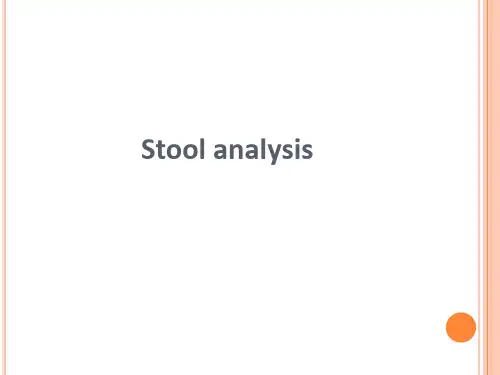
英文中的大小便怎么说英文中的大小便怎么说一名中国留学生初到美国,在机场找厕所,问老外:“WhereisW.C.?”老外听不懂。
一名中国太太到医院生产,洋护士问她:“Didyouhaveabowelmovement?”她却听不懂。
还有人学了几十年的,还不晓得英语里的“大便”、“小便”和“放屁”真正应该怎么说。
至于性毛病,更是老中难于启齿、欲语还羞的尴尬。
见到洋医生,窘迫万分,不知如何开口才是,真有”犹抱琵琶半遮面”的感受。
以下为一些“禁忌”(taboo)的美语之整理。
毕竟这些都是咱们日常的一部分,说不定有一天这些”禁忌”之语还能”派上用场”呢!一、厕所厕所在美国一般都叫restroom或bathroom(男女厕均可),或分别叫做men’sroom或ladies’room(=powderroom)。
不过在飞机上则叫lavatory,在军中又叫latrine。
至于W.C.(watercloset)仍是过去英国人用的,在美国几乎没有人使用。
此外,john(j小写时,不是男人名字)是bathroom或toilet的意思(也叫outhouse),这通常是指在户外工作场地所使用的.临时或流动性厕所(有时前面也加portable一字)。
不过,也有老外把家里的厕所叫做john。
例如:·Thereareseveral(portable)johnsintheconstructionsite.(在建筑场地有几个临时厕所。
)·Hewenttothejohnafewminutesago.(他在几分钟前上了厕所。
)·Th emanuallaborshavetouse(portable)johnsduringtheirworki nghours.(劳动者在工作时间内需要使用流动性厕所。
)二、解小便解小便最普通的说法是tourinate(名词是urination)。
如果去看病,护士为了化验小便,就会给你一个杯子说:“Will (could)youurinateinthiscup?”医生或许也会问:“Doyouhavetroubleurinating?”=Doyouhavedifficultyvoiding?(小便有困难吗?)此外,还有的说法:topiss=totakeapiss=totakealeak=tovoid=toempty。
检测幽门螺旋杆菌的方法
1. 呼气测试(Helicobacter pylori breath test):通过测量呼出气中的碳14或碳13等同位素来检测幽门螺旋杆菌。
2. 胃镜检查(Gastroscopy):通过胃镜检查,取胃黏膜组织进行组织学、细胞学或免疫组化检查来检测幽门螺旋杆菌。
3. 血清学检查(Serology):通过检查血液中的血清抗体,来判断是否感染了幽门螺旋杆菌。
4. 粪便检查(Stool antigen test):通过检测粪便中的幽门螺旋杆菌抗原来判断是否感染了幽门螺旋杆菌。
5. 快速尿素酶测试(Rapid urease test):通过取胃黏膜标本,使用尿素-酶底涂片或尿素碳13泡沫测试, 检测尿素酶活性,来检测幽门螺旋杆菌感染。
6. 分子生物学检查(Polymerase chain reaction test):通过取胃黏膜标本或口腔黏膜标本,检测幽门螺旋杆菌的DNA,对幽门螺旋杆菌的片段进行扩增并检测分析来判断是否感染了幽门螺旋杆菌。
粪便检查英语流程Stool examination is a crucial diagnostic tool in the field of medicine. It provides valuable information about an individual's gastrointestinal health and can help identify various medical conditions. The process of stool examination, also known as fecal analysis or stool test, involves the collection, analysis, and interpretation of a patient's stool sample. This essay will guide you through the step-by-step procedure of stool examination in English.The first step in the stool examination process is the collection of the stool sample. Patients are typically instructed to collect a small amount of their stool in a clean container provided by the healthcare facility. It is important to ensure that the sample is not contaminated with urine or water. Patients may be asked to collect the sample first thing in the morning or at a specific time of day, as the composition of the stool can vary throughout the day.Once the sample is collected, it is transported to a laboratory for analysis. The laboratory staff will then perform a series of tests on the stool sample to assess its physical characteristics, chemicalcomposition, and the presence of any abnormal components.One of the most common tests performed on a stool sample is the macroscopic examination. This involves a visual inspection of the stool sample to assess its color, consistency, and the presence of any visible abnormalities, such as blood, mucus, or undigested food particles. The color of the stool can provide valuable information about the patient's digestive health. For example, a pale or clay-colored stool may indicate a problem with the liver or gallbladder, while a dark, tarry stool may be a sign of gastrointestinal bleeding.The consistency of the stool is also an important factor in the macroscopic examination. A hard, dry stool may indicate constipation, while a loose, watery stool may be a sign of diarrhea. The presence of blood, mucus, or undigested food particles can also provide clues about the underlying medical condition.After the macroscopic examination, the laboratory staff will perform a microscopic examination of the stool sample. This involves the use of a microscope to identify any microscopic organisms or abnormal cells that may be present in the stool. The microscopic examination can help detect the presence of parasites, such as Giardia or Cryptosporidium, as well as the presence of red blood cells, white blood cells, or other abnormal cells.In addition to the macroscopic and microscopic examinations, the laboratory may also perform chemical tests on the stool sample. These tests can measure the levels of various substances, such as fecal fat, fecal occult blood, or fecal calprotectin, which can provide information about the patient's digestive health.The interpretation of the stool examination results is typically done by a healthcare professional, such as a gastroenterologist or a primary care physician. They will review the results of the various tests and use this information to make a diagnosis or to guide further medical treatment.It is important to note that the interpretation of stool examination results can be complex and may require additional testing or follow-up. Patients should always consult with their healthcare provider to discuss the results of their stool examination and to determine the appropriate course of action.In conclusion, the stool examination process is a critical diagnostic tool in the field of medicine. It involves the collection, analysis, and interpretation of a patient's stool sample to assess their gastrointestinal health and to identify any underlying medical conditions. By understanding the step-by-step procedure of stool examination, patients can better prepare for this important test andwork with their healthcare providers to ensure the best possible outcome.。
布里斯托大便分类法英文缩写The Bristol Stool Scale is a medical tool used to classify the form of human feces into seven categories. Each category is represented by a number and a description, ranging from Type 1 (separate hard lumps) to Type 7 (watery). This scale is commonly used by healthcare professionals to assess the overall health of the digestive system and to diagnose various gastrointestinal conditions.The Bristol Stool Scale was developed by Dr. Ken Heaton at the University of Bristol in the 1990s. It has since become a widely recognized and accepted method for categorizing stool consistency. The scale is particularly useful in the diagnosis and treatment of conditions such as irritable bowel syndrome, constipation, and diarrhea.The seven types of stools classified by the Bristol Stool Scale are as follows:Type 1: Separate hard lumps, like nuts (hard to pass) Type 2: Sausage-shaped, but lumpyType 3: Like a sausage but with cracks on the surfaceType 4: Like a sausage or snake, smooth and softType 5: Soft blobs with clear-cut edges (passed easily) Type 6: Fluffy pieces with ragged edges, a mushy stoolType 7: Watery, no solid pieces (entirely liquid)中文:布里斯托大便分类法是一种用于将人类粪便形态分类的医学工具,分为七个类别。
一坨一坨的。
其实shit这个单词,没学过英语的人应该都会哦,因为实在太普遍……不过,表示同一意思的还有几个其他的单词:
excrement:排泄物
一般去医院做检查时,如果要化验大便的话,医生肯定不会跟你说shit这个单词,而是feces,或者stool,那么这种化验就被称为stool test
孩童一般会用poo这个词,发音如此可爱,用来指代这张图里一坨一坨的~应该更加合适
吧^^
(王菲在微博发了自己这张素颜照,微博原文:“脸妹洗吃么糊(眼屎)害有点儿肿~ p.s. 谁负折把黑眼圈儿搁我ps喽~” 小编表示:素颜什么的最有爱了!)
于是~说说“眼屎”这个词吧,英文中用gum来表示,可是gum这个词最常见的意思是“口香糖”,所以为避免混淆,可以补充说gum in the eyes
其实小时候大人一直教育我们不要随便扣鼻屎什么的……
“鼻屎”在英文中是用booger来表示,British English中是bogeys。
学名nasal mucus
英国美食家、作家Stefan Gates在他的一本书Gastronaut (美食家)中曾写到有关eating nasal mucus的内容…
最后一个词:earwax,耳朵里的蜡,就是“耳屎”啦~我们平时用来挖耳屎的那个东东,就叫做earwax removal,一般医生都建议用棉签,cotton stick,对耳朵比较好~。